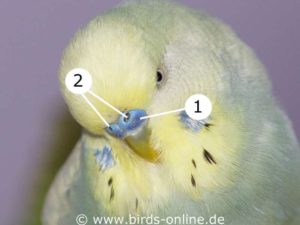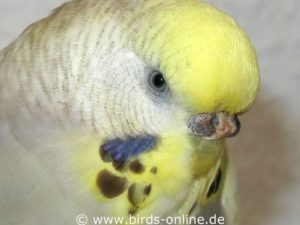- >>
- Birds Online – English
- >>
- Health and diseases
- >>
- General health topics
- >>
- Bird anatomy
- >>
- Nose and cere
Nose and cere

The nose of a budgie is located above the upper beak. Only the outer parts of the nose are visible. The nasal cavities are located behind this visible part of the nose. It’s a naked and waxy shimmering skin that is referred to as the cere (1). It has a left and a right side, in each of them there is one nostril (2) in the upper part. In most budgies, the nostrils are oval, their size is individually different. If a bird is healthy, the edges of the nares are smooth and even. One should be able to look through these openings and see some details of the nasal cavities. If this is not possible, the nose could be clogged.
With the help of the coloring of the cere, one can identify the sex of the budgies. In adult females, it is usually brown or very delicately light-blue. In contrast, it is bright blue or pink in sexually mature males. Because of the sex-related coloring of the cere, it is regarded as an external sexual characteristic of the budgies. The intensity of the cere’s color mainly depends on the hormonal status (breeding condition or not) as well as on the color variety of the plumage. However, it can also indicate whether a bird is seriously ill. Under certain circumstances, the cere changes its color because of an underlying disease.

In most budgies, the cere is flat and smooth (males) or slightly curved and crusty (females in breeding conditions). If it strongly bulges and looks like a tiny horn, the reason for this is often an excessive keratinized growth of the cere, which occurs particularly in female budgies. This is because of their high estrogen level. This phenomenon of keratinized cere is called hyperkeratosis. Sometimes it requires treatment because in the worst case, the nostrils can become blocked. Also, if an infestation with parasites (scaly mites) occurs, the look of the cere can dramatically change. Then it’s often covered with thick, whitish to brownish crusts and thus appears bulged, although it is only hidden under thick coverings.
Injuries of the cere or the nose can occur due to different causes, for example as a result of a fight with another bird or a collision with a windowpane. In certain cases, the birds bleed heavily and need to be treated by an avian vet as soon as possible. You will find advice in the chapter “Treating wounds” (soon to come) in case your budgie suffers from an injury of the cere.
